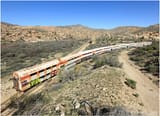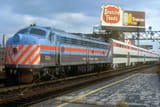Anonymous
4/14/2025, 9:31:59 AM
No.2038870
[Report]
>>2039300
>>2039520
>>2044527
>>2046756
>>2050923
>>2055046
>>2056942
>>2057523
The Impossible Railroad: Is it really impossible?
>The San Diego and Arizona Eastern Railway (reporting mark SDAE) is a short-line American railroad founded in 1932 as the successor to the San Diego and Arizona Railway (SD&A), which was founded in 1906 by entrepreneur John Spreckels. Dubbed "The Impossible Railroad" by many engineers of its day due to the immense logistical challenges involved, the line was established in part to provide San Diego with a direct rail link to the east by connecting with the Southern Pacific Railroad lines in El Centro, California.
>the railroad has a checkered history, with periodic disruptions in service to rockslides, storms, fires, and derailments, and has never been profitable
>the line ceased being used in its entirety decades ago and has been bounced around by owner to owner ever since
>at present, only a fraction of the line in San Diego, Mexico, and Campo is actively used, with the rest being left to decay
Here's my questions:
1. Were the "Impossible Railroad's" issues inherent to the climate and terrain, or more so the technological/economic limitations at the time of its construction (the railroad was built with anachronistic infrastructure such as wooden trestles)?
2. If funding could secured, would it be possible to rehabilitate or even rebuild the line in its entirety using modern engineering techniques to negate the hazards that plagued its previous incarnations?
3. What services could be provided to make the line economical, or even turn an actual profit? Obviously there's tourism, Carrizo Gorge attracts thousands of tourists a year (many of whom come to gawk at the ruins of the railway). I recently found out that the Mexican portion of the line is used to host the Tijuana-Tecate Tourist Train (pic related, several gallery cars that were originally intended for it but ultimately left unused) and has proven quite popular. But I'm also wondering industries could be served or even if a US-Mexico commuter service would be feasible (ignoring current diplomatic issues)
>the railroad has a checkered history, with periodic disruptions in service to rockslides, storms, fires, and derailments, and has never been profitable
>the line ceased being used in its entirety decades ago and has been bounced around by owner to owner ever since
>at present, only a fraction of the line in San Diego, Mexico, and Campo is actively used, with the rest being left to decay
Here's my questions:
1. Were the "Impossible Railroad's" issues inherent to the climate and terrain, or more so the technological/economic limitations at the time of its construction (the railroad was built with anachronistic infrastructure such as wooden trestles)?
2. If funding could secured, would it be possible to rehabilitate or even rebuild the line in its entirety using modern engineering techniques to negate the hazards that plagued its previous incarnations?
3. What services could be provided to make the line economical, or even turn an actual profit? Obviously there's tourism, Carrizo Gorge attracts thousands of tourists a year (many of whom come to gawk at the ruins of the railway). I recently found out that the Mexican portion of the line is used to host the Tijuana-Tecate Tourist Train (pic related, several gallery cars that were originally intended for it but ultimately left unused) and has proven quite popular. But I'm also wondering industries could be served or even if a US-Mexico commuter service would be feasible (ignoring current diplomatic issues)




